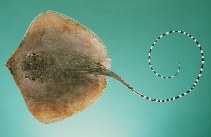
|
Maculabatis gerrardi (Gray, 1851) Sharpnose stingray |

|
|
photo by
Randall, J.E. |
| Family: | Dasyatidae (Stingrays), subfamily: Urogymninae | |||
| Max. size: | 200 cm TL (male/unsexed) | |||
| Environment: | demersal; brackish; marine; depth range - 50 m | |||
| Distribution: | Indo-West Pacific: Oman to Indonesia; north to Taiwan. | |||
| Diagnosis: | ||||
| Biology: | Likely confined to the inner continental shelf (Ref. 9840), over sandy and mud bottoms (Ref. 30573). Recorded from coastal waters and river mouths (Ref. 45255). Feeds on bottom crustaceans including shrimp, crabs and small lobsters (Ref. 5578). Ovoviviparous (Ref. 50449). Important food fish, the skin and flesh are dried or used to produce leather for purses and bags (Ref. 9840). Caught in very large quantities in the demersal tangle net, bottom trawl and trammel net fisheries. Utilized for its meat, skin (high value) and cartilage (Ref. 58048). It is parasitised on the dorsal skin surface by the monogeneans Dendromonocotyle citrosa, D. colorni, D. ukuthena (Ref. 124058) and D. lotteri (Ref. 124051). | |||
| IUCN Red List Status: | Endangered (EN); Date assessed: 06 May 2020 (A2d) Ref. (130435) | |||
| Threat to humans: | harmless | |||